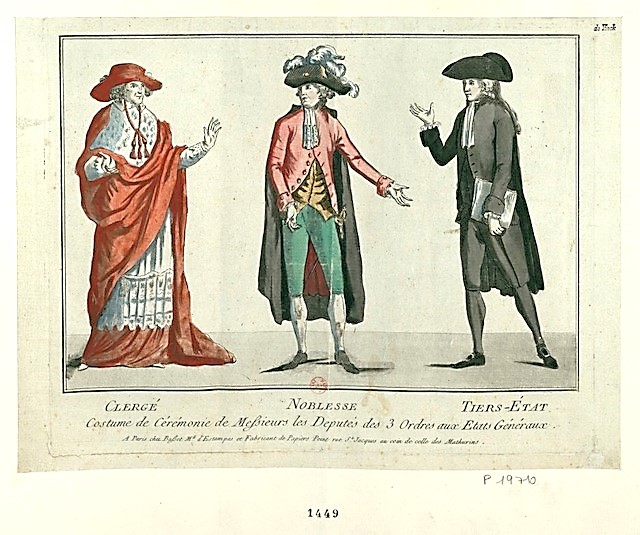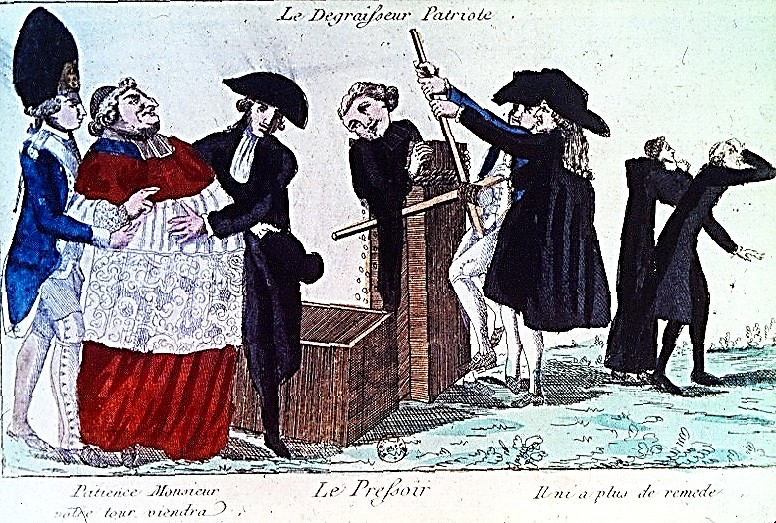Garry Otton looks at cartoons, a genre that still refuses to take religion seriously.
When, in 2004, Mrs Diane Duyser from Florida found an image of Jesus Christ on a toasted cheese sandwich, she kept it for 10 years claiming it never went mouldy. It fetched $28,000 at auction. The Book of Revelation in the Bible is based on a series of such visions and the Catholic Church have made saints of people who have claimed to have seen Jesus. Unfortunately, any vision of Christ today is more likely to appear on the internet than staring up from a grilled cheese sandwich!

Taking the Mickey out of anyone’s imaginary friend even gets its own name: Blasphemy. Even without locking people up or sentencing blasphemers to death, critics bemoan the lampooning of religion as an obstruction to interfaith dialogue. But alongside polite critiques in ‘quality broadsheets’, religion has been an object of mockery, scorn and humour for as long as holy books have been printed.
At the start of the French revolution in 1788, ordinary people were dying of starvation on the streets. It wasn’t just Marie-Antoinette’s famous wigs or Louis XVI’s opulent Palace of Versailles that was casting a long shadow over the peasantry: the clergy were enjoying a substantial slice of the cake too.
The general assembly representing the French estates of the realm, the Estates-General was sliced into three portions: The First Estate represented 100,000 Catholic clergy with the Church owning about 10% of the land and taxing the poor. The lands were controlled by bishops and abbots of monasteries. The Second Estate represented the nobility, about 400,000 men and women who owned about 25% of the land and collected rents from their tenants. The Third Estate was 610 men who represented 95% of the population. Half were well educated lawyers or local officials. Nearly a third were in trades or industry; 51 were wealthy landowners.

Many of the thousands of newspapers and pamphlets rolling off the printing presses during the French Revolution were read aloud in pubs. They also offered an opportunity for cartoonists to turn their satirical guns on the pious elite enjoying their impenetrable privileges. It is somewhat ironic that it was guns that would eventually be turned on the cartoonists in France, propelling little-known satirical magazine, Charlie Hebdo into a household name.

In the midst of France’s financial crisis, the popular Jacques Necker, a foreigner, was appointed Comptroller-General of Finance. He could not become an official minister as he was a Protestant. Necker wanted to reform the French tax system, borrow money and cut the exemptions awarded to the clergy and nobility which was such a heavy burden on the poor. Jacques Necker was sacked.
For the first time in a century, the king called a meeting of the Estates-General.
A minority of Protestants living in France, such as the Huguenots, wanted an anti-Catholic regime and revenge against the clergy who discriminated against them. Enlightenment thinkers such as Voltaire fuelled this resentment by denigrating the Catholic Church and upsetting the French monarchy. The Church was hit hard during the revolution by the National Assembly after it abolished the authority of the Church to impose the tithe and forced it to give its property back to the nation. There was so much property that it backed a new currency, the assignats. By 1789 France was paying the clergy and caring for the poor, the sick and the orphaned. It later abolished monastic vows, dissolved all religious orders and encouraged monks and nuns to return to private life.


Under Maximilien Robespierre the Revolution brought major reforms under what became known as the Reign of Terror between 1793 and 1794 which, along with many executions, also saw price controls on food, the abolishment of slavery in the French colonies and the dissolution of religious privilege which saw Catholic leaders expelled and the creation of a new non-religious calendar in 1793 with 10-day weeks making it difficult for Catholics to remember Sundays, (renamed Decadi), and saints’ days. Workers complained it reduced the number of first-day-of-the-week holidays from 52 to 37 and 22 September 1792 was made the first day of the new Republic which was made Year One on the new French Republican Calendar. Each day in the Republican Calendar was divided into ten hours, each hour into 100 decimal minutes, and each decimal minute into 100 decimal seconds. Thus an hour was 144 conventional minutes (more than twice as long as a conventional hour), a minute was 86.4 conventional seconds (44% longer than a conventional minute) and a second was 0.864 conventional seconds (13.6% shorter than a conventional second).

Robespierre’s tried to launch a Cult of Reason but it was so unpopular he was forced to give it a religious twist to make it more appealing and launched the Cult of the Supreme Being celebrated with festivals all over France.

The festivals were led by goddesses of Reason and it was decreed they should be selected from women ‘whose character renders beauty respectable and whose severity of morals and manners repulses license.’ Unfortunately, that ideal wasn’t always reached. A particularly elaborate affair was the enthronement of the Goddess in the Notre Dame, re-named the Temple of Reason. In a party mood, troops of ballet girls carried torches of truth and the Archbishop of Paris, a Calvinistic minister and almost all of the clergy stripped of their canonicals and danced in red nightcaps. Carlyle wrote in his book, French Revolution, “Mrs Momoro, it is admitted, made one of the best goddesses of Reason, though her teeth were a little defective.”
Michelet wrote disparagingly in his Femmes de la Révolution how he met a former goddess of Reason whom was chosen as an exemplary matron with blameless morals, but scathingly observed that she was far from beautiful, “and what is more, she squinted.”
The statue of Liberty, placed over the entrance of the Palais Royal, was modelled on another goddess of Reason, Madame Thérésa Tallien who had her moment celebrating a feast of Reason in Bordeaux. She was said to bathe in strawberry juice and was famous for turning up at the Paris Opera in a white silk dress without any underwear. Talleyrand commented: “Il n’est pas possible de s’exposer plus somptueusement!” (One could not be more richly unclothed!)
Women, particularly in rural areas, saw the closure of the churches as a great loss and joined the counter-revolutionary movement. They refused to sell their goods for assignats or attend masses held by priests pledging loyalty to the Republic. They continued to hold Christian burials and named their children after saints in spite of the risks attached to going against the revolutionary decrees.

The counter-revolutionary movement led to incidents like the Revolt in the Vendée where tens of thousands were massacred. The war epitomised the conflict between religious tradition and the revolutionary foundation of democracy. It was a cruel birth for France’s epitaph and cry of Liberté, égalité, fraternité, of liberalism, secularism, universal suffrage, feminism and human rights.

In England, in the year Thomas Paine had written Rights of Man, cartoons depicted the plight of dissenting clergyman which included the inventor of soda water Joseph Priestley after he sparked the Birmingham Riots of 1791. He had helped organise a banquet in Birmingham’s Royal Hotel in sympathy with French revolutionaries. Priestley’s home was torched and, fuelled by looted liquor, so too were four Dissenting chapels, 27 houses, businesses and homes of members of the Lunar Society.

The Concordat of 1801 between Napoleon and the Church ended the de-Christianization period in France and established the rules for a relationship between the Catholic Church and the French State that lasted until it was abrogated by the Third Republic via the separation of church and state on 11 December 1905. It would not signal the end of anti-clerical cartoons though. Far from it.

By 1882, Léo Taxil’s La Bible Amusante (The Amusing Bible) with cartoons by Frid’rick was published by Libraire anticléricale. Taxil, who had been brought up in a Jesuit seminary claimed he had intended to demonstrate the inconsistencies, errors and false beliefs in the Bible and to “kill them with laughter.” He was accused of mocking the Bible while The Times called for the book of cartoons to be suppressed.



In 1885, Taxil converted to Catholicism renouncing all his publications before he was solemnly received into the church. He went on to attack Freemasonry with the help of a Masonic High Priestess Miss Diane Vaughan whose essays declared that Masons admitted women, indulged in orgies, committed ritual murders, political assassinations and worshipped Satan in their lodges with the intention of destroying Christianity. It was all an elaborate hoax. Taxil nonetheless managed to convince Pope Leo XIII who invited him and a pretty young woman Taxil introduced as Miss Vaughan to Rome. The Pope, after giving permission for an international conference on Masonry in Trento, Italy in 1896 even sent Taxil his blessings and defended his anti-Masonic literature. The pressure was on for Taxil to show Miss Vaughan in the flesh which he promised to do in a lecture in Paris in 1897. It was here he told a stunned audience: “Diana Vaughan… It’s me!” Taxil went on to tell the audience, many of whom were priests, “My reverend fathers, I sincerely thank my colleagues at the Catholic press and our lords the bishops for helping me organise this great mystery, which will crown my career.” Taxil spent his later years publishing cookbooks before he died in 1907.

George W. Foote, a President of the National Secular Society loved Taxil and Frid’rick’s cartoons and published them in his own magazine The Freethinker which he had launched in the UK in 1881. Foote declared, “The Freethinker is an anti-Christian organ, and must therefore be chiefly aggressive. It will wage relentless war against superstition in general, and against Christian superstition in particular. It will do its best to employ the resources of Science, Scholarship, Philosophy and Ethics against the claims of the Bible as a Divine Revelation; and it will not scruple to employ for the same purpose any weapons of ridicule or sarcasm that may be borrowed from the armoury of Common Sense.”
Anti-religious cartoons in the Christmas 1882 edition saw Foote prosecuted by devout Catholic, Justice North for blasphemy and sentenced to 12 months’ imprisonment with hard labour.
Foote wrote in his book Prisoner of Blasphemy: “Voltaire’s method of attacking Christianity has always approved itself to French Freethinkers. They regard the statement that he treated religious questions in a spirit of levity as the weak defence of those who know that irony and sarcasm are the deadliest enemies of their faith. Superstition dislikes argument, but it hates laughter. Nimble and far-flashing wit is more potent against error than the slow dull logic of the schools; and the great humourists and wits of the world have done far more to clear its head and sweeten its heart than all its sober philosophers from Aristotle to Kant. We in England have Comic Histories, Comic Geographies, and Comic Grammars, but a Comic Bible would horrify us…” adding his intention to add cartoons to The Freethinker, he added: “we shall reproduce in the Freethinker some of the raciest plates. We shall be greeted with shrieks of pious wrath if we do so, but we are not easily frightened.”
Foote cut through the class barrier with his publications. He wrote in Prisoner of Blasphemy: “It is difficult to find a book by any eminent scientist or thinker which does not contain open or covert attacks on Christianity and Scripture, and the Archbishop of Canterbury has pathetically complained that it is dangerous to introduce high-class magazines to the family circle, because they are nearly sure to contain a large quantity of sceptism. Why are these propagators of heresy never molested? Because it would be perilous to touch them. Prosecutions are always reserved for those who are unprotected by wealth and position. Heresy in expensive books for the upper classes is safe, but heresy in cheap publications for the people incurs a terrible danger. The one is flattered and conciliated, while the other is liable at any moment to be put on its defence in a criminal court, and is always at the mercy of any man who may choose to indulge his political animosity, his social enmity, or his private spite.”
We can only wonder what Foote would have made of the current climate of middle-class political correctness, ‘non-platforming’ and tip-toeing around ideological sensibilities. He was first introduced to secularism by a friend who took him to a secular hall where he “heard Mrs (Harriet) Law knock the Bible about delightfully. She was not what would be called a woman of culture, but she had what some devotees of ‘culchaw’ do not possess – a great deal of natural ability…” He would have had a long wait for any change in the law. The blasphemy laws wouldn’t be repealed in Britain until 2008 and they still remain in place in Northern Ireland.


On 30th September, 2005, the Danish newspaper Jyllands-Posten entered a debate on self-censorship and criticism of Islam with 12 cartoons from different artists of prophet Muhammad. Muslim imams provoked widespread furore including the firebombing of Danish embassies and violent protests around the world which led to reports of over 200 deaths. The cartoons were defiantly reprinted in newspapers around the world in solidarity and International Blasphemy Rights Day became remembered on this day each year.

The pious in France have always had a particularly difficult relationship with cartoons. Following the efforts of the French Book Board, headed by Catholic Abbé Jean Pihan in the fifties, cartoons like Tarzan were censored. This muscular, half-clothed, bestial and poorly educated drawing of a boy from the jungle was deemed contrary to good morals. While American imports, Tarzan and Flash Gordon perished in the cartoon cull, Tintin, Lucky Luke and Les Stroumpfs (The Smurfs) triumphed over the censors. The Board put pressure on comic publishers to paint-out the busts of shapely females and cover any scantily-clothed seductresses. Deploring the behaviour of characters like Superwoman who fought against men, Pihan published his own Catholic comic books Coeurs Vaillants and Âmes Vaillantes. (Brave Hearts and Valiant Souls) where women played what he considered their proper role as wives and mothers.
After satirical magazine Charlie Hebdo printed the Danish cartoons depicting Muhammad they were taken to court. Charlie Hebdo was acquitted of charges that it incited hatred. In 2011 editor Stéphane Charbonnier, known as Charb, published a cover depicting Muhammad as gay and another issue called Charia Hebdo satirically featured Muhammad as its guest editor as a voice of reason supporting secularism. The magazine’s website was hacked and the offices were firebombed.

In 2015 two masked gunmen screaming “Allahu akbar!” opened fire on staff and police officers killing 12 people, including Charb and several prominent cartoonists. The “Je Suis Charlie” meme went viral in response. It wasn’t the last attack on cartoonists. In February 2015 a gunman opened fire on attendants and police officers at a meeting discussing freedom of speech with the Swedish cartoonist Lars Vilks among the panellists.

In 2013, the cartoons of Jesus and Mo came up for discussion in the BBC’s religious Big Questions programme. The production team stopped participants from being shown wearing t-shirts, one of which depicted Jesus saying ‘Hey!’ and the other of Muhammad saying ‘How ya doing?’ Muslim politician Maajid Nawaz left the studio in disgust at the censorship and tweeted the tops before receiving death threats.

In 2016, regulatory body Ofcom claimed they’d received 170 complaints about an episode of Fireman Sam first shown in 2014. It appeared to show a character putting his boot on a page of the Koran and slipping on it. Ofcom studied the recording in “the highest possible resolution” but couldn’t work out what was on the page, let alone whether or not it was a page of the Koran. A spokesperson for Mattel, the company who also make Bob the Builder and Thomas the Tank Engine appeared distraught. “The page was intended to show illegible text and we deeply regret this error. We sincerely apologise for any distress or offence it may have caused.” They said they would “no longer be working with the animation studio responsible”, and intended to take “immediate action to remove (the) episode from circulation.” The episode was pulled from Channel 5’s streaming service, My5.

In the same year, a prominent Jordanian writer, Nahed Hattaran was shot dead outside the Supreme Court in Amman. He had been arrested for posting a cartoon on Facebook. An Arab TV host cheered the secular writer’s assassination on television. The wife of Nahed Hattar said: “I saw his lifeless, blood-drained body just now. His two children saw him shot and killed before their eyes. And for what? For sharing a cartoon on Facebook?”


The struggle to bestow rights to people instead of ideologies has been a long and arduous one. The law against blasphemy was only repealed in the UK in 2008, and even then it excluded Northern Ireland. Ireland re-introduced its blasphemy law in 2010 and Scotland introduced a blasphemy law by the back door with the controversial Offensive Behaviour at Football and Threatening Communications (Scotland) Act 2012, ostensibly to curb sectarian behaviour at football matches, but explicitly making it an offence to hate a religious group.
Hopefully we will continue to be challenged creatively and resist the urge to censor. Glib pronouncements that there have to be limits on free speech are all too often precursors for the setting of boundaries by the those who wish to exercise their own prescription for limitations on freedom of speech. Chastising an ideology is not the same as personal abuse and hatred of an individual. And tip-toeing round religion does nothing to challenge its self-imposed propriety.
Religious critique is not the reserved domain of intellectual arguments in highbrow newspapers. Words and pictures are for everybody. Some think they are funny; others don’t. As the French would say: C’est la vie.

Garry Otton 2016
